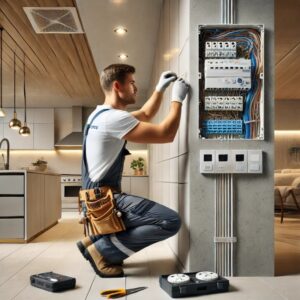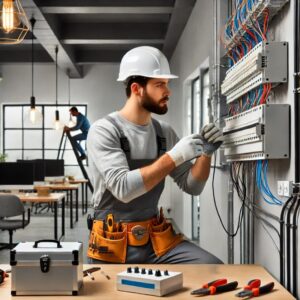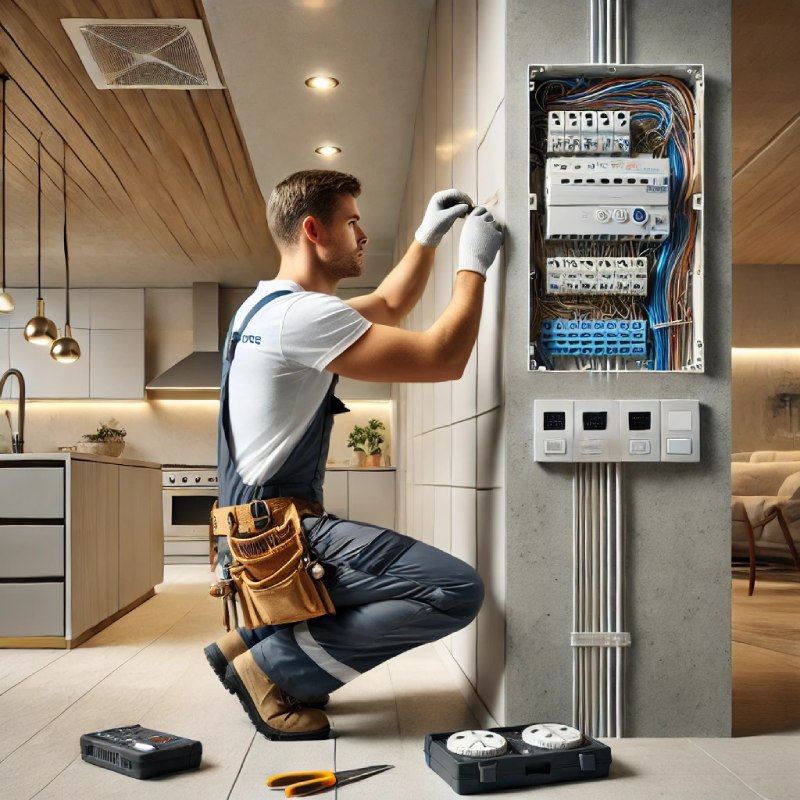Troubleshooting Residential Electrical Wiring: Ensure safety and efficiency with professional services from Rising Sun Electrify.
Understanding Residential Electrical Wiring
Basic Components of Residential Wiring
Residential wiring systems comprise several key components. These include the service panel, circuits, outlets, switches, and the wiring itself. The service panel is the central hub where electricity from the utility company is distributed throughout the house. Circuits are the pathways that carry electrical current to various outlets and devices. Understanding these components is essential for troubleshooting and maintaining your home’s electrical system.
Common Electrical Issues in Homes
Common electrical issues in homes can range from minor inconveniences like flickering lights to more serious problems such as frequent breaker trips or dead outlets. These issues often stem from outdated wiring, overloaded circuits, or faulty installations. Recognizing these problems early can prevent potential hazards and ensure your electrical system operates efficiently.
Importance of Proper Wiring
Proper wiring is vital for the safety and efficiency of your home. Incorrectly installed or outdated wiring can lead to electrical hazards, including fires and shocks. Ensuring your home’s wiring is up to code and handled by professionals minimizes these risks and enhances the overall functionality of your electrical system.
Safety Concerns and Precautions
Working with electricity involves significant safety risks. Always turn off the power at the main panel before attempting any electrical work. Use insulated tools, wear rubber-soled shoes, and never work on live circuits. These precautions are essential to prevent electrical shocks and injuries.
Tools Needed for Electrical Work
Having the right tools is crucial for any electrical work. Essential tools include a voltage tester, wire strippers, needle-nose pliers, screwdrivers, and electrical tape. A multimeter can also be invaluable for diagnosing electrical issues. Investing in quality tools ensures safety and efficiency in your electrical projects.
Professional vs. DIY Wiring
While some minor electrical repairs can be DIY projects, significant wiring work should always be handled by professionals. Licensed electricians have the expertise and experience to ensure that all work meets safety standards and building codes. Hiring a professional can prevent costly mistakes and ensure the long-term safety and reliability of your electrical system.
Identifying Electrical Problems
Recognizing Flickering Lights
Flickering lights can be an annoying and sometimes alarming issue. This problem often indicates a loose bulb or a faulty fixture. However, it can also signify more serious issues like loose wiring connections or problems within the electrical circuit. Regularly checking and tightening connections can help identify and resolve these issues early.
Dealing with Frequent Breaker Trips
Frequent breaker trips are a common problem in many households. This usually happens when a circuit is overloaded or there’s a short circuit. Identifying the cause involves checking which devices are connected to the circuit and ensuring they do not exceed the circuit’s capacity. If the issue persists, it might be necessary to consult a professional to inspect the wiring and circuit breaker.
Identifying Dead Outlets
Dead outlets are another frequent issue that homeowners encounter. This can result from a tripped circuit breaker, a blown fuse, or a loose wire connection. Checking the breaker panel and resetting any tripped breakers can often restore power. If the outlet remains dead, further investigation of the wiring and connections behind the outlet may be needed.
Understanding Electrical Shocks
Experiencing electrical shocks when touching appliances or switches can be a sign of serious electrical faults. This could be due to improper grounding, damaged wiring, or faulty appliances. Ensuring that all electrical systems are properly grounded and inspecting for any visible damage can help mitigate this risk. Professional inspection is recommended to ensure safety.
Signs of Overloaded Circuits
Overloaded circuits occur when too many devices are drawing power from a single circuit. Common signs include flickering lights, buzzing outlets, and warm switch plates. Distributing the electrical load across multiple circuits and unplugging non-essential devices can alleviate this issue. Upgrading the electrical panel may also be necessary to handle increased power demands.
Troubleshooting Power Surges
Power surges can damage electronic devices and appliances. They are often caused by lightning strikes, power outages, or faulty wiring. Installing surge protectors at key points in your electrical system can provide a first line of defense. For comprehensive protection, consider installing a whole-house surge protector to safeguard all devices and appliances in your home.
Fixing Flickering Lights
Common Causes of Flickering Lights
Flickering lights are often caused by simple issues like loose bulbs or faulty light switches. However, they can also indicate more serious problems such as loose wiring or overloaded circuits. Identifying the root cause is essential for ensuring your home’s electrical safety and efficiency.
How to Check Light Fixtures
Begin troubleshooting flickering lights by checking the light fixture itself. Ensure the bulb is securely screwed in. If the bulb is secure and the flickering persists, inspect the fixture’s wiring for any loose or damaged connections. Replacing the fixture may be necessary if the problem is within the fixture itself.
Evaluating Wiring Connections
Loose wiring connections can cause lights to flicker. Turn off the power at the breaker panel and check the wiring connections in the fixture and switch. Ensure all connections are tight and secure. Loose wires should be properly reconnected and secured with wire nuts to prevent further issues.
When to Replace Light Switches
Faulty light switches can also cause flickering lights. If the switch feels warm to the touch or if the lights flicker when the switch is used, it may be time to replace it. Replacing the switch can often resolve flickering issues and improve the overall safety of your electrical system.
Checking for Voltage Fluctuations
Voltage fluctuations can lead to flickering lights. Use a multimeter to check the voltage at the light fixture. Consistent readings outside the normal range (110-120 volts) may indicate a problem with the electrical supply or internal wiring. Consulting a professional electrician can help diagnose and correct voltage issues.
Professional Solutions for Persistent Issues
If flickering lights persist despite your troubleshooting efforts, it may be time to call in a professional electrician. Persistent flickering can indicate serious issues such as wiring problems, overloaded circuits, or faults in the electrical panel. A professional can perform a thorough inspection and provide the necessary repairs to ensure your home’s electrical safety and reliability.
Addressing Frequent Breaker Trips
Understanding Circuit Breakers
Circuit breakers are essential safety devices that protect your home from electrical overloads and short circuits. When too much current flows through a circuit, the breaker trips to prevent overheating and potential fires. Understanding how breakers work helps in diagnosing why they might be tripping frequently.
Common Causes of Breaker Trips
Frequent breaker trips can be caused by several factors, including overloaded circuits, short circuits, or ground faults. Overloaded circuits occur when too many high-wattage devices are used simultaneously. Short circuits happen when a hot wire touches a neutral wire, creating a sudden surge of electricity. Ground faults occur when a hot wire touches the ground wire or a grounded part of the junction box.
Steps to Reset a Tripped Breaker
To reset a tripped breaker, first, identify the breaker that has tripped. It will be in the “off” position or in between the “on” and “off” positions. Turn the breaker all the way off, then flip it back to the “on” position. If the breaker trips again immediately, there may be a more serious issue that requires professional attention.
How to Identify Overloaded Circuits
Identifying overloaded circuits involves understanding the capacity of each circuit in your home. Check the breaker panel to see the amperage rating for each circuit and ensure the combined wattage of devices on that circuit does not exceed this rating. Unplugging some devices or redistributing them to other circuits can alleviate the overload.
Upgrading Your Electrical Panel
If frequent breaker trips are a constant issue, it might be time to upgrade your electrical panel. Older panels may not be able to handle the electrical demands of modern appliances and technology. Upgrading to a panel with a higher capacity can provide more circuits and better distribution of electrical load, reducing the likelihood of trips.
When to Call an Electrician
While some breaker trips can be resolved with simple troubleshooting, persistent or unexplained trips warrant a call to a professional electrician. An electrician can perform a comprehensive inspection, identify the underlying issues, and recommend appropriate solutions. This ensures your home’s electrical system operates safely and efficiently.
Resolving Dead Outlets
Diagnosing Dead Outlets
Dead outlets can be frustrating and inconvenient. The first step in diagnosing a dead outlet is to check if it’s just one outlet or several. If multiple outlets are affected, the issue might be with the circuit breaker. For a single outlet, inspect it for any visible damage or burn marks that could indicate an electrical problem.
How to Check Outlet Wiring
To check the wiring of a dead outlet, start by turning off the power at the breaker panel. Remove the outlet cover and use a voltage tester to ensure there’s no electricity flowing. Check the wiring connections to ensure they are secure. Loose or disconnected wires are often the culprit behind a dead outlet.
Replacing Faulty Outlets
If the wiring appears to be intact and secure, the outlet itself might be faulty. Replacing a faulty outlet is a straightforward task. Ensure you have the correct type of outlet and follow proper safety procedures. After replacing the outlet, turn the power back on and test the outlet with a voltage tester to ensure it’s working correctly.
Inspecting GFCI Outlets
Designers created Ground Fault Circuit Interrupter (GFCI) outlets to protect against electrical shocks. If you have a dead GFCI outlet, you might need to reset it. Press the “reset” button on the outlet to restore power. If the outlet still doesn’t work, you may need to replace it or further inspect it for wiring issues
Ensuring Proper Grounding
Proper grounding is crucial for electrical safety. Check that the outlet is properly grounded by inspecting the ground wire connection. A properly grounded outlet helps protect against electrical shocks and ensures the outlet functions correctly. If you find issues with grounding, it’s best to consult a professional electrician for repairs.
Safety Tips for Outlet Repairs
When working on outlet repairs, always prioritize safety. Turn off the power at the breaker panel and use insulated tools. Never work on live circuits and always double-check that the power is off before starting any work. If you’re unsure about any aspect of the repair, it’s safer to call a professional electrician to handle the job.
Preventing Electrical Shocks
Common Causes of Electrical Shocks
Electrical shocks can occur due to various reasons such as damaged cords, faulty appliances, improper grounding, or exposed wires. Understanding these common causes is the first step in preventing shocks and ensuring a safe home environment. Regular inspection of your electrical system can help identify potential hazards early.
Inspecting Electrical Devices
Regularly inspecting your electrical devices is crucial for safety. Check for signs of wear and tear, such as frayed cords or damaged plugs. Ensure that all devices are in good working condition and that there are no exposed wires. If any device appears damaged, replace it immediately to avoid the risk of electrical shock.
Ensuring Proper Insulation
Proper insulation of wires and electrical components is essential to prevent shocks. Insulation prevents the electrical current from escaping its intended path. Inspect wires and cables for any cracks or damage in the insulation. Replace any damaged insulation to ensure the safety and efficiency of your electrical system.
Replacing Damaged Cords
Damaged cords pose a significant risk of electrical shocks. If you notice any fraying, cuts, or exposed wires in a cord, it should be replaced immediately. Using electrical tape to temporarily fix the cord is not a safe long-term solution. Investing in high-quality replacement cords can prevent accidents and ensure reliable operation.
Ground Fault Circuit Interrupters (GFCI)
Installing Ground Fault Circuit Interrupters (GFCI) in areas with a high risk of electrical shocks, such as kitchens, bathrooms, and outdoor outlets, enhances safety. GFCIs detect imbalances in electrical current and quickly shut off power to prevent shocks. Regularly test your GFCIs to ensure they are functioning correctly.
Professional Inspection and Maintenance
Regular professional inspections and maintenance of your electrical system are vital for safety. A licensed electrician can identify potential hazards, ensure all components are up to code, and perform necessary repairs. This proactive approach helps prevent electrical shocks and maintains the overall safety of your home.
Managing Overloaded Circuits
Symptoms of Overloaded Circuits
Overloaded circuits often show signs such as flickering lights, buzzing outlets, and frequent tripping of circuit breakers. Warm or discolored wall plates, burning odors, and mild shocks from appliances can also indicate an overloaded circuit. Recognizing these symptoms early can help prevent potential hazards like electrical fires.
How to Distribute Electrical Load
To manage and distribute electrical load effectively, avoid plugging too many high-wattage appliances into a single circuit. Spread out the use of appliances across different circuits and unplug devices that are not in use. Using dedicated circuits for high-power appliances like refrigerators and air conditioners can also help distribute the load evenly.
Adding New Circuits
If your home’s electrical demand frequently overloads existing circuits, consider adding new circuits. This involves installing additional breakers and wiring to create new pathways for electricity. This solution helps to balance the load more effectively and provides additional capacity for new appliances and devices.
Upgrading to a Larger Service Panel
For homes with consistently high electrical demands, upgrading to a larger service panel can be beneficial. A larger panel increases the number of available circuits and overall electrical capacity. This upgrade is especially useful for older homes that were not designed to handle modern electrical loads.
Safe Use of Extension Cords
While you can use extension cords as temporary solutions for electrical needs, do not use them as a permanent fix for overloaded circuits. Ensure you rate extension cords for the intended load and avoid daisy-chaining multiple cords together. Using extension cords safely can prevent overloading and reduce the risk of electrical fires.
Professional Load Assessment
A professional load assessment by a licensed electrician can provide a comprehensive understanding of your home’s electrical needs. The electrician can evaluate your current system, identify potential issues, and recommend appropriate solutions such as load balancing, circuit additions, or panel upgrades. This assessment ensures your electrical system can safely handle your home’s demands.
Handling Power Surges
Causes of Power Surges
Power surges can be caused by various factors including lightning strikes, power outages, and the sudden powering on or off of high-demand electrical devices. Internal causes such as faulty wiring or damaged electrical components can also lead to surges. Identifying the source of power surges is crucial for implementing effective protective measures.
Protecting Your Home with Surge Protectors
Surge protectors are essential for safeguarding your home’s electrical devices against power surges. These devices divert excess voltage away from plugged-in electronics, preventing damage. Invest in high-quality surge protectors for sensitive electronics like computers, TVs, and kitchen appliances.
Installing Whole-House Surge Protectors
For comprehensive protection, consider installing a whole-house surge protector. You install this device at your main electrical panel, and it protects all the electrical devices in your home. Whole-house surge protectors particularly effectively protect against external surges caused by lightning or issues with the power grid.
Inspecting and Replacing Damaged Wiring
Damaged or outdated wiring can increase the risk of power surges. Regularly inspect your home’s wiring for any signs of wear, such as fraying or discoloration. Replace any damaged wiring promptly to prevent potential surges. Hiring a professional electrician for this task ensures that the work is done safely and up to code.
Ensuring Stable Electrical Supply
Maintaining a stable electrical supply involves ensuring that your home’s electrical system is not overloaded and that all circuits are properly balanced. Avoid using too many high-power devices on a single circuit and consider upgrading your electrical panel if necessary. A stable supply reduces the likelihood of surges and extends the lifespan of your electrical devices.
Professional Surge Protection Solutions
For optimal protection against power surges, consult a professional electrician. They can assess your home’s electrical system, recommend the best surge protection solutions, and install necessary devices. Professional solutions often include a combination of point-of-use surge protectors and whole-house surge protectors, providing layered defense against surges.
Conclusion
Ensuring Electrical Safety and Efficiency
Maintaining a safe and efficient electrical system in your home is crucial for preventing common issues and potential hazards. From addressing frequent breaker trips to managing overloaded circuits, understanding and troubleshooting your residential electrical wiring can save you time, money, and stress.
Professional Expertise You Can Trust
Rising Sun Electrify is dedicated to providing top-notch electrical services to ensure your home is safe and efficient. Our team of certified electricians in Hayward, CA, has the expertise to handle all your electrical needs, from minor repairs to major upgrades. With our commitment to quality and customer satisfaction, you can trust us to keep your home’s electrical system running smoothly.
Comprehensive Services for Every Need
Whether you’re dealing with flickering lights, dead outlets, or the need for an electrical panel upgrade, we offer comprehensive solutions tailored to your specific needs. Our professional inspections and maintenance services help identify and resolve issues before they become major problems, ensuring the long-term safety and reliability of your electrical system.
Contact Rising Sun Electrify Today
For all your residential electrical wiring needs, contact Rising Sun Electrify. Our team is ready to assist you with expert solutions and exceptional service. Call us at (510) 788-9092 to schedule a consultation or service appointment.
Why Choose Us?
- Expertise: Our certified electricians have years of experience and in-depth knowledge.
- Quality: We use the highest-quality materials and adhere to strict safety protocols.
- Customer Satisfaction: We prioritize your satisfaction with our professional, timely, and meticulous services.
Google Reviews
Don’t just take our word for it. See what our satisfied customers have to say about us on Rising Sun Electrify Reviews.
FAQs
Q: Why do my lights flicker occasionally?
A: Flickering lights can be caused by loose bulbs, faulty light switches, or more serious issues like loose wiring or overloaded circuits. It’s best to inspect the fixture and wiring or consult a professional if the problem persists.
Q: What should I do if my circuit breaker keeps tripping?
A: Frequent breaker trips often indicate an overloaded circuit, a short circuit, or a ground fault. Try redistributing the electrical load and resetting the breaker. If the issue continues, contact a professional electrician to inspect your system.
Q: How can I tell if an outlet is dead?
A: If an outlet doesn’t work, check for visible damage, test other outlets on the same circuit, and inspect the circuit breaker for trips. If the outlet remains dead, the wiring or the outlet itself may need replacement.
Q: What causes electrical shocks from appliances or switches?
A: Electrical shocks can result from improper grounding, damaged wiring, or faulty appliances. Ensuring all electrical systems are properly grounded and regularly inspecting appliances can help prevent shocks.
Q: How can I protect my home from power surges?
A: Use high-quality surge protectors for sensitive electronics and consider installing a whole-house surge protector. Regularly inspect and replace damaged wiring, and consult a professional for comprehensive surge protection solutions.











